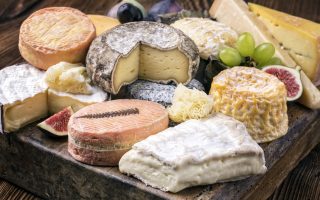The wonderful walnuts of Corrèze
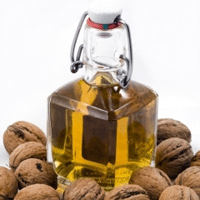

Earlier this year we were invited by a friend who lives in Corrèze to join her as she took her home grown organic walnuts to be pressed and made in to oil. We thought it would be nice to see the process through from start to finish.
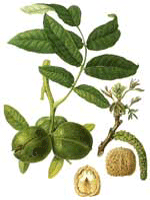
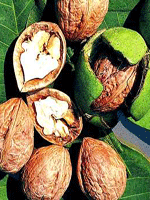
The taste and texture of the freshly picked nuts in early autumn is unbeatable, it’s a creamy ‘fresh’ taste. The Perigord is the main walnut producing area of France and once you have eaten them direct from the producer you will not wish to return to the ‘dusty’ shop-bought variety.
The nuts had spent their time drying naturally under the warm, summer sun in giant trays. After which our friend, along with a team of elderly neighbours had spent an afternoon shelling the nuts. An activity that we are told is a traditional, seasonal social évent – a chance for a good gossip and catch up around the long tables as the work gets done. Now bagged and weighed the nuts were all ready to be turned in to the luxurious oil.

Following a very enjoyable five course lunch we set off to the farm where the processing was to take place. We expected some kind of sanitised, stainless steel preparation area, conforming to EU health and safety standards.
But here in Limousin things are still done in the time honoured fashion of the ancestors and this was to be no different. We were greeted on arrival by a friendly and jovial Mr Gaston in statutory blue work overalls, supervised by the obligatory Bretagne spaniel at his feet.
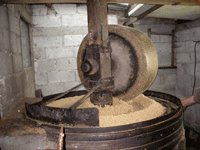
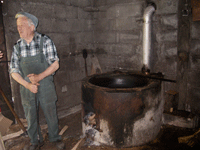
We were ushered in to a little out building and watched as he tipped all the nuts on to giant old mill stone. A rather dubious motor was kicked in to action and the large ancient wheel slowly began to turn and crush the nuts. Rather excitedly we peered underneath to see where the oil was coming out. Mr Gaston could not hide his hilarity at our ignorance and proceeded to explain that this was the preliminary stage and there were several more processes to come before the oil would be extracted, whoops!
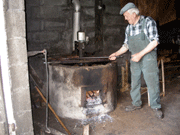
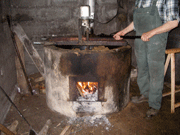
While the giant mill pounded away at the nuts, Mr G. lit a fire below a giant pot. After much poking and examination of the crushed nuts they were declared ready for stage two. The powder was shovelled in to the giant pot and a rather Heath Robinson type stirring device was suspended above to keep the mix agitated as it warmed. The smell slowly started to emerge and could only be described as intoxicatingly delicious.
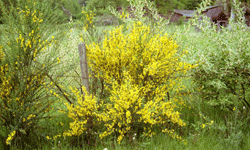
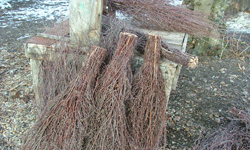
To keep us entertained while we were waiting for the nuts to heat Mr.G treated us to a broom making demonstration. Mr G. selected twigs from a large pile of dried broom sticks and with a couple of twists, turns and flicks of the wrist fashioned little hand brushes.
We all tried to replicate his technique but failed miserably!
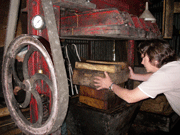
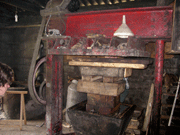
Mr G. periodically dipped his finger in to the mix, his finger proving to be remarkably accurate and heat proof thermometer. The giant press was prepared. Once again a rather dangerous looking piece of equipment held together with various bungees and supported by giant chocks of wood. All hands were now required on deck as the heated nuts had to be pressed quickly before cooling. As the press slowly moved down a stream of warm golden liquid began to pour in to a large galvanised jug.
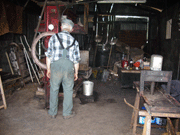
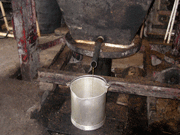
To celebrate, I am not sure what, Mr G opened a bottle of his home made Pineau, not a drink I am normally fond of but this really was delicious and went extremely well with the little home made walnut cakes we were served.
Finally we were dispatched with walnut oil, cider vinegar (taken each morning in warm water is good for cholesterol apparently) , and several bottles of home made cider, Mr G’s other sideline when he is not producing walnut oil.
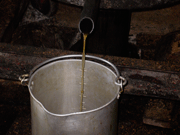
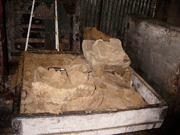
More about Walnut Oil
This expensive, delicate specialty oil is generally made in the Perigord and Burgundy regions of France, though there are also producers in Australia, New Zealand, and California. Short cuts in the production process causes the taste and quality of the oil to vary tremendously. Some producers simply macerate the nuts in vegetable oil. Others do not roast them after grinding. While others, for aesthetic reasons, over-filter to give a clear and pristine-look to the product. They all are doing the oil a disservice. Macerating gives little or no flavor to the oil; roasting is necessary for the rich nutty flavor (The label should always read that the nuts have been roasted), and too much filtering extracts too much flavor.
Once you see how versatile it really is, I doubt it will sit around for long.
Walnut oil is not a cooking oil; high heat destroys its delicate flavor. Where it does shine is as an ingredient in a salad dressing or a fresh pasta sauce or to give a final splash over a finished dish.
Some delicious ideas for walnut oil
• Mixed with a little cream and medium dry sherry, it gives class to a piece of freshly poached salmon or chicken breast. A few toasted walnuts add texture and decoration.
• A mix of walnut oil, sherry vinegar, a touch of garlic, prepared mustard, and salt makes an excellent dressing for an endive and radicchio salad. Top the salad with a sprinkle of crumbled blue cheese.
• Walnut oil is a delicious alternative to olive oil in classic vinaigrettes or for dipping fresh bread. Either try it on its own, or with a splash of sherry vinegar, Cabernet Sauvignon vinegar or verjuice.
• Finish off a bowl of fresh sorrel soup with a drizzle of walnut oil.
• Walnut oil is fantastic tossed through pasta. With a soft blue cheese such as Gorgonzola, steamed fresh green beans or spinach, sautéed mushrooms or simply parsley and garlic.
• Use walnut oil to grease ramekins and moulds for desserts such as panna cotta. It will add a delicate, nutty dimension.
• For a festive breakfast or a Sunday brunch, try walnut and pear bruschetta (substitute bananas if you don’t like pears). Grill a thick slice of panettone, brioche or fruit bread, drizzle with walnut oil, top with slices of ripe pear, a few toasted walnuts and lashings of maple syrup, honey or chocolate sauce. Serve with thick Greek yogurt, whipped cream or mascarpone.
• Brush halved fruit such as peach or nectarine with a combination of walnut oil and honey before roasting or grilling, and serve with yoghurt or ice-cream.
• Goats’ cheese marinated in walnut oil is delicious with a salad and some crusty bread as a summer lunch. You can use the remaining oil for dressings or through pasta or potatoes.
• Lay 1cm slices of goats’ cheese in a dish and sprinkle with some fresh thyme, crushed garlic and freshly ground black pepper. Drizzle with walnut oil, cover and leave in a cool place to marinate for 24 hours. This is also good with a few chopped dried porcini mushrooms.
• In the winter, parsnips and Brussels sprouts taste great tossed with walnut oil before serving, or add some to mashed potato, carrot and parsnip.
• Brush walnut oil on fish, poultry and especially duck before grilling or pan frying. Or drizzle some around the plate before you serve.
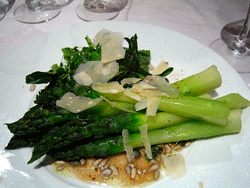
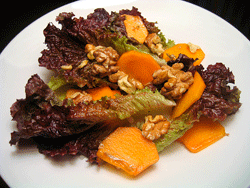
Share to: Facebook Twitter LinkedIn Email
More in activity, burgundy, cooking, health, renovation, summer, work
By FrenchEntrée
Leave a reply
Your email address will not be published. Required fields are marked *



